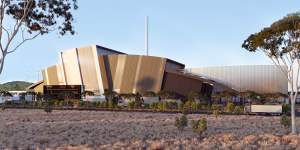But in the age of the circular economy,nothing is further from the truth:waste is becoming a source of valued recoverable material such as metals,biogases and nutrient-rich by-products suited for fertiliser.

Waste management giant Veolia’s proposed $600 million,energy-from-waste facility at Woodlawn NSW,would produce an estimated 240,000-megawatt hours of energy per year – enough to power 40,000 homes. (Artist’s impression.)Supplied
At the same time,reducing landfill volumes in the first place is paramount as current facilities reach capacity and suitable sites become harder to find.
“Rather than creating more landfill,Australia can do better as a nation in terms of diverting waste material for recycling and other materials,” says waste industry leader Veolia’s local CEO Richard Kirkman.
The new way of thinking about waste as a resource is enshrined in the 2018 National Waste Policy Action Plan,a manifesto agreed to by federal,state and local governments.
Thinking big on garbage
The document outlines the key principles for avoiding waste in the first place by greater recycling,improved resource recovery,better managing the material flows and improving information for support consumers and investors.
Crucially,the document targets reducing the total waste generated in Australia by 10 per cent by 2030 and achieving 80 per cent average waste recovery from all waste streams by that year.
Other targets are phasing out “problematic and unnecessary” plastics by 2025 and halving the amount of organic waste sent to landfill by 2030.
But performance to date suggests that more action is required if we are to have any chance of meeting these aims.
Representing about 65 per cent of the waste management industry,The National Waste and Recycling Industry Council describes progress as “limited”.
The council notes per-capita waste generation has increased by more than 3 per cent against a 2016-17 baseline.
“The … likelihood of reaching these targets is tenuous at best,” the NWRIC says in a response to a biennial review of the goals.
According to the government’s National Waste Report 2022,Australians generated 75.8 million tonnes (mt) of waste in 2020-21,2.4 per cent higher than previously.
Of the total resource,63 per cent was recovered,mainly via recycling (60 per cent) and energy-from-waste (EFW) projects (3 per cent).
The data also shows a big variation between waste streams,with 87 per cent recovery of metals and an impressive 81 per cent recovery for the building and demolition sector.
But only 13 per cent of plastics were recovered,while more easily recycled paper and cardboard gets an “improvement needed” scorecard with 62 per cent recovery.
The NWRIC notes that every Australian is generating more than 2.95 tonnes of waste each year.
“As Australia’s population grows,the only way to prevent more waste going to landfill will be urgent and concurrent increased investment in both processing infrastructure and developing long-term end user markets across all recycled material streams,” the council says.
“At the same time,Australia must also maximise the benefit of residuals from wastes being generated and the economic and climate change opportunities this delivers.”
The promise of energy from trash
Despite the doubts about meeting the targets,there’s no lack of resolve on the part of industry and the community to address the issues.
Technology solutions are also coming to the fore,such as next-generation EFW plants that convert putrescent or mixed waste into gas,electricity or heat energy.
In the case of Veolia,the company is investing heavily in at least five existing or proposed energy from waste facilities – the first large-scale projects of their ilk in the country.
Energy-from-waste (EFW) works either by a thermal (incineration) process,or anaerobic digestion which uses bacteria in an oxygen-free space to convert organic matter to usable methane and a nutrient-rich fertiliser.
A secondary benefit is that the captured methane otherwise would be emitted over time as a powerful greenhouse gas.
In a game-changer for the west,Veolia will soon operate two thermal plants in Perth – at Kwinana and East Rockingham – which will take care of hard-to-recycle “red bin” material such as nappies or soiled cardboard.
The material is burnt at high temperature,to produce steam or run a turbine.
In NSW,Veolia has applied for planning approval for a facility at an existing landfill site and former base metals mine at Woodlawn,near Tarago in the state’s south-east.
The $600 million-plus Woodlawn project would be the country’s biggest such facility,producing 240,000 megawatt hours of energy per year – enough to power 40,000 homes.
In Victoria,Veolia is part of a consortium vying to build an EFW plant to provide cheap and reliable energy to the Maryvale paper mill,a major employer in the region.
Meanwhile,Veolia is reopening a revamped building – an anaerobic digestion plant,EarthPower,at Camellia in western Sydney. The only large-scale,food-to-waste facility in the area,EarthPower at full capacity would produce enough power for more than 4000 homes.
Veolia’s Kirkman says EFW plants are a crucial component of a suite of solutions to enable the 80 per cent target to be reached.

Veolia’s local CEO Richard Kirkman.Supplied
“There’s a big opportunity for Australia,” says Kirkman. “There’s always a moment of hesitation in terms of adopting new technology ... but any advanced society doing well managing their waste has this tech and we would be missing out if we didn’t do it.”
As well as making environmental sense,increasing recoveries makes sound economic sense as well.
According to the National Waste Policy Action Plan,an average 9.2 jobs are created for every 10,000 tonnes recycled,with $2.9 billion realised through sales of recovered materials.
“By working together,businesses,governments,communities and individuals can support our economy,while protecting human health and reducing environmental impacts,” the document says.
To find out more,please visit.